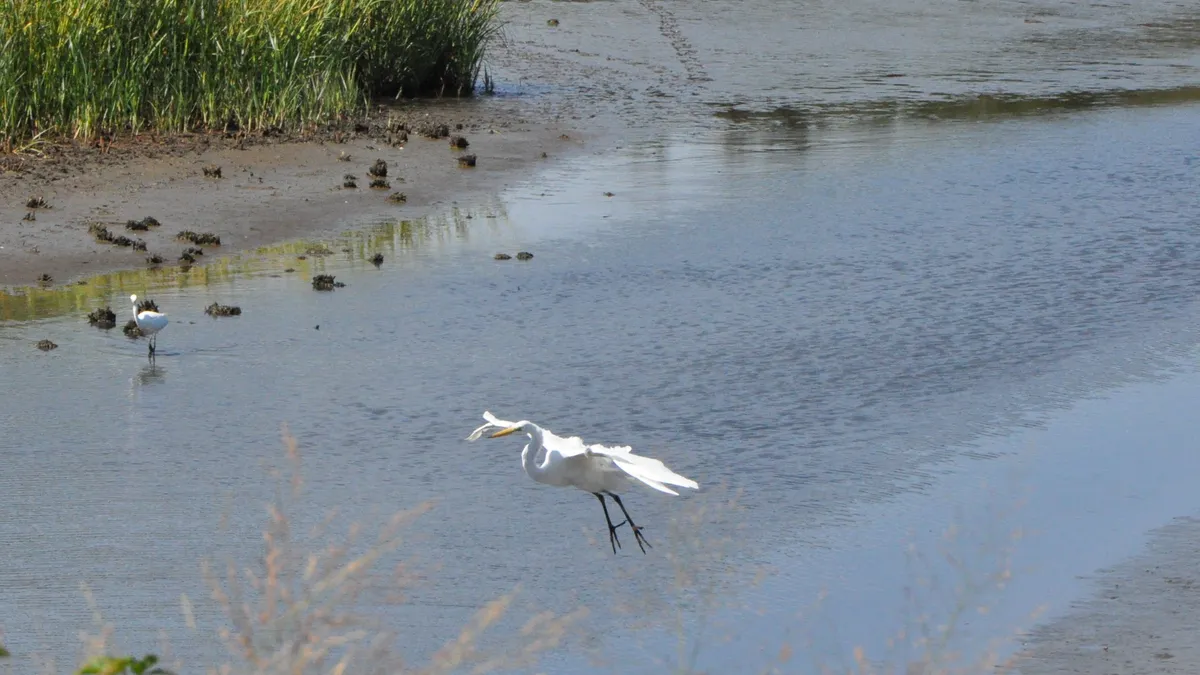
The Delaware Birding Trail highlights accessible spots throughout the state for bird watching.
Delaware is a favorite destination of serious birders because of its location and geography.
Birding groups offer tips and advice for people starting the hobby like why fall is a favorable time.
Fall could be the best time for birdwatching in Delaware, and a ready-made route can guide you to some of the best places to see our feathered friends in a state that’s a top birding destination.
The Delaware Birding Trail is a map with 27 recommended sites, compiled by the Delaware Ornithological Society, Delaware Audubon, Delaware Department of Natural Resources and Environmental Control and its Division of Fish and Wildlife.
“The intent behind the birding trail was to make important Delaware birding areas accessible to newcomers and beginners,” said Joseph Francis, president of the Delaware Ornithological Society.
Considerations included sites near major highways and roads, adequate parking and handicapped-accessible trails where possible.
“Those who frequent the sites on the trail may have noticed the improvements that have taken place,” Francis said, including viewing platforms with ramps that literally elevate the experience.
And for a birding experience, Delaware in the fall is tough to beat because of its location on the eastern flyway for many migrating species along with several types of geography in a concentrated area.
The hills along Delaware’s northern border are similar to upstate New York or northern Pennsylvania, but only 70 miles away, on the state’s sandy pine flatlands, it’s like the Carolinas, according to the Delaware Birding Trail website, along with habitats in marshes and along the river, bay and ocean.
The state has six, ecologically based birding regions:
Piedmont hills and valleys
Delaware River coast
Delaware Bay coast
ocean beaches and inland bays
cypress and pine areas
forest and farmland
“Spending time in multiple birding regions will naturally increase the number of species you encounter,” according to the Birding Trail website.
The trail includes White Clay Creek State Park, Ashland Nature Center, Brandywine Creek State Park, Wilmington State Parks, Fort duPont State Park, Fort Delaware State Park, Thousand Acre Marsh, Lums Pond State Park, Woodland Beach Wildlife Area, Bombay Hook National Wildlife Refuge, Little Creek Wildlife Area, Ted Harvey Conservation Area, Killens Pond State Park, Milford Neck, Slaughter Beach, Abbott’s Mill Nature Center, Prime Hook National Wildlife Refuge, Redden State Forest, Nanticoke Wildlife Area, Cape May-Lewes Ferry, Cape Henlopen State Park, Silver Lake in Rehoboth, Delaware Seashore State Park, James Farm Ecological Preserve, Assawoman Wildlife Area, Great Cypress Swamp and Trap Pond State Park.
Recent park news: Delaware state parks seeking public input on future fee increases
Francis said one new birding “hotspot” not mentioned in the original Birding Trail is the Woodlawn Tract of First State National Historic Park, along the Brandywine River, “a superb example of mid-Atlantic deciduous forest that hosts a great variety of breeding and migrating songbirds.”
While the management of the trail information is going through a transition, the webite is still available with a list of all the sites, a map and birds species at delawarebirdingtrail.com.
Why is autumn probably the best time for bird watching in Delaware?
“There are more birds than any other time of year, because you are seeing both returning adults as well as the young that fledged the nest that summer,” said Francis.
Migrating birds stay longer.
“During the spring, birds are in a hurry to get to their breeding grounds and set up nesting territories. In the fall, they can take a more leisurely pace and, where food is good, ‘fatten up’ for the journey,” Francis said.
Autumn is the best time to see migrating birds of prey like hawks, eagles and falcons.
It’s also when more rare and out-of-place birds, what birders call “vagrants,” appear in Delaware.
“These are often young birds that are migrating for the first time and ‘get lost.’ Certain groups of birds from the western United States, such as flycatchers, tanagers or hummingbirds are routinely seen in Delaware during the fall,” Francis said. “Some birders make a point of going out the days after a storm or hurricane passes to see what surprises the wind has blown in from far away.”
Two favorite spots for birders in Delaware, especially in the fall, are the national wildlife refuges along the coast at Bombay Hook east of Smyrna and Prime Hook east of Milton. More people usually visit in the spring and fall to see migrating birds but also because conditions are more pleasant with cooler temperatures and fewer biting insects, said Kate Toniolo, project leader at the Coastal Delaware National Wildlife Refuge Complex.
In early autumn visitors can see migrating shorebirds, warblers and birds of prey. Later in the season, wintering waterfowl like tundra swans and northern shovelers arrive.
“All these birds draw folks in, but people definitely want to see the high numbers of snow geese in and around the refuge,” Toniolo said.
Snow geese blanket the area in sea of white.
“They generally don’t arrive until colder weather pushes them south, so if we have a mild autumn we will see them later,” Toniolo said.
How does Toniolo explain the appeal of bird watching?
“Birds are wildlife with a lot of personality that are very accessible,” she said. “You can see birds in any environment – urban, rural, marsh, woods. Birdwatching is an easy, enjoyable and peaceful way to connect with nature.”
More autumn ideas: 11 tasty Delaware food & beer festivals for fall 2025
Opportunities to look for species with other birders
Francis said the best part of birding is making friends with people who share a common interest.
The Delaware Ornithological Society and the Delaware Nature Society offer bird walks and field trips, so check their websites. The Ornithological Society also hosts a youth birding group for ages 18 and under and their parents.
Delaware Audubon has bird walks and a book club for bird enthusiasts.
The Sussex Bird Club, based in Lewes, offers educational presentations and field trips.
Here are examples of programs at Bombay Hook Wildlife Refuge:
Bird walk Sept. 27 at 8 a.m., led by the Delaware Ornithological Society on the Forest Discovery Tree Trail
Introduction to optics Oct. 11 at 11 a.m., to learn more about binoculars and scopes
At Prime Hook Wildlife Refuge, events include:
Guided bird walk during Family Fun Day Sept. 27, hosted by the Friends of Prime Hook and Sussex Bird Club. Registration is required.
First Saturday guided bird walks Oct. 4, Nov. 1 and Dec. 6.
What do you need to get started in birding?
While binoculars, books and apps can help identify species, Francis said to “try before you buy.” Organizers of field trips and bird walks at parks and wildlife refuges will often have loaner binoculars or viewing scopes, and you can check out different field guides at a library or on a bird walk.
As for binoculars, while there are many pricey models, you don’t need to spend a lot, especially if you’re starting the hobby. Francis said models that magnify six to eight times are “best for beginners.”
He prefers a field guide with a sturdy cover over an app because flipping through the pages is faster than searching online. His favorite guide is the second edition of “Sibley Birds East,” while others prefer “Peterson Field Guide to Birds of Eastern and Central North America,” seventh edition, and National Geographic’s Field Guide to the Birds of North America, eighth edition.
The field guide books usually list closely related birds on the same page or next page which helps with trying to identify challenging families like sparrows, warblers or flycatchers.
If you prefer apps, Francis said to try eBird, Merlin or Seek by iNaturalist. Some apps have examples of a bird’s song which can be helpful because often you hear a bird before you see it.
The most important equipment, though, is what keeps you safe and comfortable.
“Be sure to have sturdy, trail-worthy shoes, a hat to protect you from the sun, insect repellent, sunscreen and bottled water,” Francis said.
Reach reporter Ben Mace at rmace@gannett.com.



